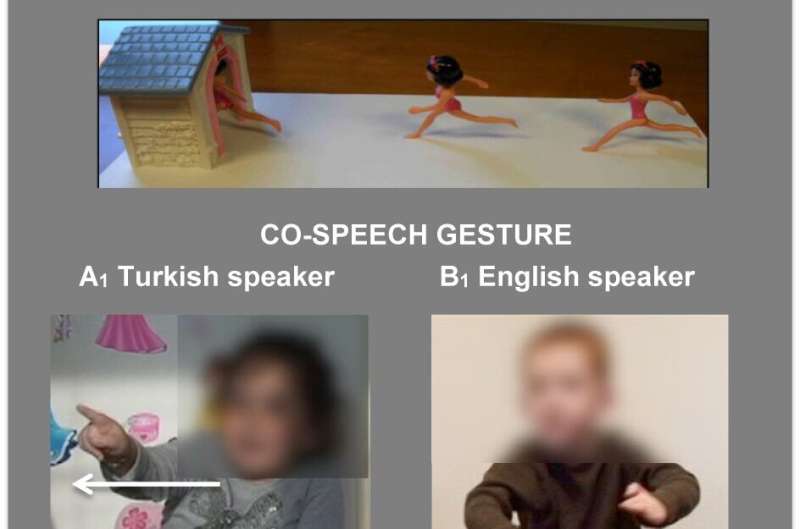This article has been reviewed according to Science X's editorial process and policies. Editors have highlighted the following attributes while ensuring the content's credibility:
fact-checked
peer-reviewed publication
trusted source
proofread
Study suggests existence of a universal, nonverbal communication system

Recent research conducted at Georgia State University shows that native language affects how people convey information from a young age and hints at the presence of a universal system of communication.
Şeyda Özçalışkan, a professor in the Psychology Department, has been researching the connection between language and thought for years. Her latest study, "What the development of gesture with and without speech can tell us about the effect of language on thought," published in Language and Cognition, is a continuation of previous work with adults.
For this study, Özçalışkan, in collaboration with Susan Goldin-Meadow at the University of Chicago and Che Lucero at Cornell University, focused on children ages 3 to 12. The children either spoke English or Turkish. They were asked to use their hands to act out specific actions, such as running into a house.
"English and Turkish were the primary comparisons because they differ in terms of the way you talk about events," said Özçalışkan, a native Turkish speaker herself.
"If you're speaking Turkish, if you want to describe someone running into a house, you have to chunk it up. You say, 'he's running and then he enters the house,'" she said. "But if it's in English, they'll just say 'he ran into the house,' all in one compact sentence. As such, it is easier to express both running (manner of motion) and entering (path of motion) together in a single expression in English than in Turkish.
"We wanted to find out whether gesture does or does not follow these differences and how early do children learn these patterns."
Researchers asked the children to describe the same action first when speaking (speech and co-speech gesture) and then without speaking with only their hands (known as silent gesture).
They found that when the children spoke and gestured at the same time, their gesture followed the conventions of their language, with clear differences between the gestures of the Turkish and English speakers. When the children used gestures without speaking, however, their gestures were remarkably similar.
"It is easier to express both running and entering in a single gesture compared to speech, particularly for Turkish speakers who have to express running and entering in two separate sentences in their speech," said Özçalışkan. "So when you're not speaking, gesture doesn't have to follow the separation of manner and path, and, you can easily actually put them together."
The study also found that these patterns kick in at a very young age. Children's co-speech gesture first begins to follow the patterns of their spoken language at 3 to 4 years of age.
Özçalışkan, in collaboration with Goldin-Meadow, has also studied sighted and blind adults. Those participants were also English and Turkish speakers. Using the same methods as in her latest study, researchers were surprised to find the same differences in co-speech gesture and similarities in silent gesture. This was despite the fact that the non-sighted participants were blind from birth, meaning they had never seen anyone gesture before.
So far, Özçalışkan said, all the studies have produced very similar results. In fact, many of the gestures used by participants resemble what are known as "home sign systems," which are informal sign language systems that are created spontaneously by deaf children, who have not been exposed to a conventional sign language by their hearing parents.
"What we see in fact, is some of these sorts of basic structures that we see in, for instance, early sign languages," Özçalışkan said.
This pattern suggests that there may be a universal gesture system that enables us to communicate with each other regardless of language, hearing ability, or sightedness.
Özçalışkan said the next step for this research is to study blind Turkish and English-speaking children to see if the same patterns are present.
"We established in our earlier work that blind adults gesture like sighted adults… They showed differences in speech and co-speech gesture, but when they're not talking, they show similarities. So, the next question is, how early do we see evidence of that?" Özçalışkan said.
More information: Şeyda Özçalışkan et al, What the development of gesture with and without speech can tell us about the effect of language on thought, Language and Cognition (2023). DOI: 10.1017/langcog.2023.34
Journal information: Language and Cognition
Provided by Georgia State University





















